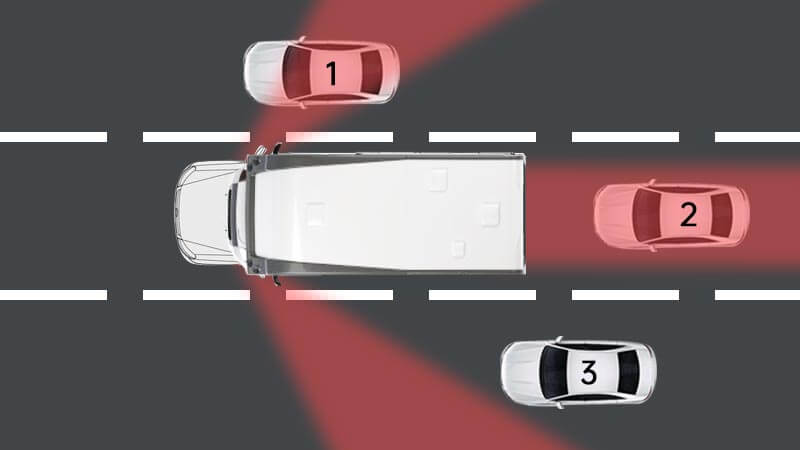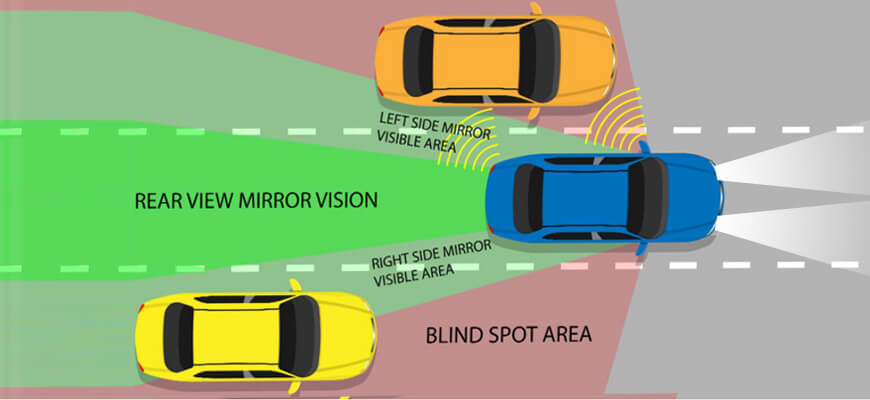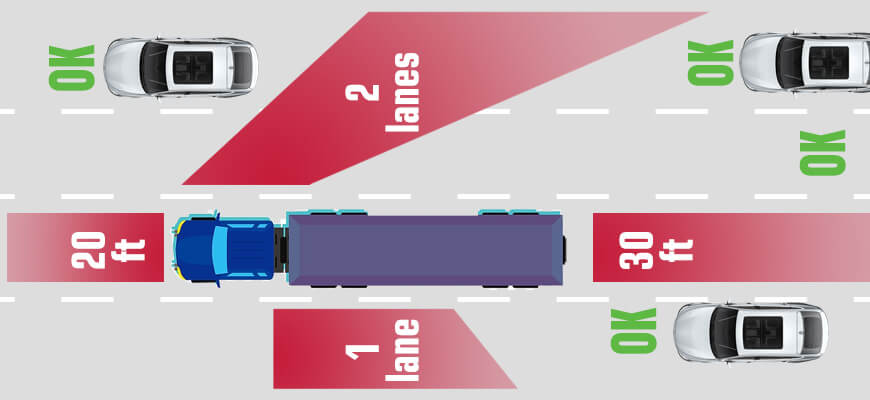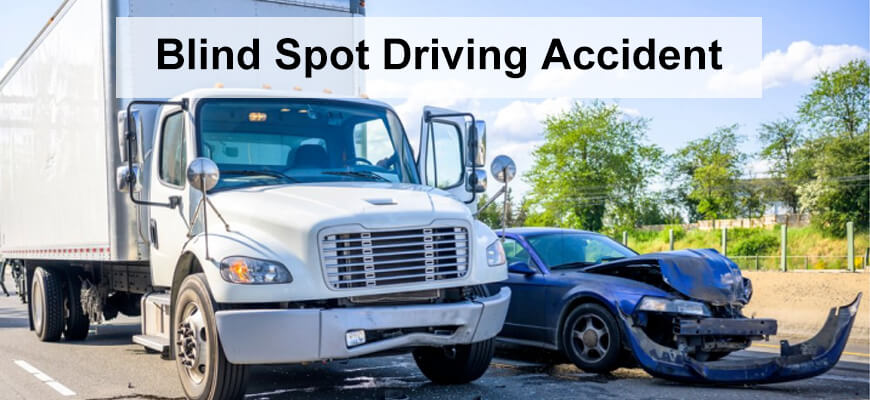
When you first started learning to drive a car, you must have heard your driving instructor constantly telling you to "check the car blind spot." Once you turn on your engine, it seems vital to check your blindspot, and you should always keep this instruction in mind. According to the National Highway Traffic Safety Administration, many accidents are caused by the blind spot of car every year. Therefore, it is beneficial for every driver to know more about vehicle blind spot. By reading this article, you will learn more about car blind spot and get some tips to reduce the risk that blind spot of your car bring.
Here is the brief content of the article:
- 1. What Are Car Blind Spots When Driving?
- 2. How Many Blind Spot on Vehicle?
- 3. Where Is the Largest Blind Spot around Your Car?
- 4. Common Causes and Damages of Vehicle Blind Spot Accident
- 5. How to Check Vehicle Blind Spot?
- 6. What Do I Do About Car Blind Spot?
1) What Are Car Blind Spots When Driving?
What is a car blind spot? As the name implies, a car blind spot is where drivers cannot see when they are in the normal driving position. Although all vehicles have side mirrors and rear-view mirrors, there are still places that drivers cannot view with the help of mirrors. All the invisible areas are called automotive blind spot.
All vehicles have blind spot. For cars, the existence of blind spot is because of the construction of the vehicles themselves. Cars are composed of a roof, floor, and pillars. These pillars block the drivers' view and cause blind spot. In general, there are four pillars. The A-pillar spans the windshield; the B-pillar is in the middle of the passenger compartment (just behind the front doors); the C-pillar sits behind the rear doors; the D-pillar is the most trailing pillar of the car. The width of the pillars has a significant impact on the size and location of the blind spot. In general, the larger the vehicle, the larger the size of the blind spot. For example, trucks have larger blind spot sizes, and we can see that many blind spot accidents are related to trucks.In addition, if you place cargo in the back of your vehicle, it will also block your view and create a car blind spot.
2) How Many Blind Spot on Vehicle?
There are four main vehicle blind spots. Naturally, they are in the front, rear, and sides. Different vehicles have different blind spot sizes and locations. Generally speaking, small cars have two (left and right sides), but large vehicles such as trunks have all four blind spots. You may have heard "no-go zone," this refers to blind spot of trunks. It means that you are so close to trunks that trunk drivers cannot safely stop or move. No-go zones are high-risk places, so avoid putting yourself in this area. If you're driving past a large truck, you'd better slow down and drive carefully to reduce the risk of an accident. The pictures below show the location of the blind spot of different vehicles, and you can check the details carefully.
Small Car Blind Spot

Large Trucks’ Blindspot When Driving

3) Where Is the Largest Blind Spot around Your Car?
As we mentioned before, the bigger the car, the larger the blind spot. Big truck may have the largest blind spot. From the image above, we can see that the right blind spot of the trunk is the most dangerous. When the truck changes lanes to the right, it will occupy the other right-hand lanes. So if you are a blind spot driver in that area, it is wise to slow down to prevent a collision.
4) Common Causes and Damages of Vehicle Blind Spot Accident
Vehicle Blind spot driving accident can be classified into various types according to the classification of driving situations. Let's look what's the common types of accidents for car blind spot and what hazards they can pose.
Causes of Blind Spot Driving Accidents
First, Lane-change accidents. Drivers have a high risk of being involved in an accident when changing lanes, and changing lanes is one of the most common reasons for vehicle blind spot accidents. So please check the car blind spot when changing lanes and turn on the signal at the same time, which will reduce a lot of risks.
Secondly, merging accidents. Vehicles need to travel faster when merging onto the highway, so drivers are supposed to be more careful, especially when they are very close to large trucks. Check the vehicle blind spot area and surroundings to make sure the current situation is suitable for merging.
Thirdly, backing vehilce blind spot accidents. The National Highway Transportation Safety Administration reports that an average of 210 deaths and 15,000 injuries are caused by backing accidents each year. Don't forget to slow down and check your car blind spot when reversing.
The Damage of the Car Blind Spot Accidents
The results depend on the seriousness of the accidents. Here is the commonly involved damage: body pain and suffering, mental trauma, medical fees, lost wages, property loss, and so on. Considering the loss, it will be worth checking car blind spot carefully.

5) How to Check Car Blind Spot?
Once you turn on your engine, you should always keep the "check blind spot of your car" instruction in mind. When you are sitting in the driver's seat, look in your rear-view mirror and check if there is any cargo placed behind the car blocking your view. If they are blocking your vision it is best to move them out of the way in advance to reduce the unnecessary blind spot caused by them. Make sure your mirrors and side-view mirrors are clear and in good condition, and adjusted to the proper position for easy use. Check your mirrors and side mirrors every 5-7 seconds while driving your car. They will tell you roughly where you are. Also, before changing lanes, do a quick shoulder check and turn on your signals to make sure you can move over safely.
6) What Do I Do About Car Blind Spot?
After discussing the questions above, you may be wondering what we can do about vehicle blind spot. There are some tips that we can use to deal with vehicle blind spot when driving.
Tip 1: Check your mirrors regularly and do some quick shoulder checks. There is a tip that all drivers can use while driving. Doing these basic tasks will make a big difference in our safety.
Tip 2: Take advantage of Blind Spot Detection (BSD) systems on your car. What is a BSD? Blind Spot Detection (BSD) is an ADAS system that alerts the driver when a vehicle is approaching from behind in an adjacent lane. It consists primarily of Aftermarket BSD systems and factory-installed BSD systems. BSD systems help drivers detect the presence of a vehicle in a vehicle blind spot, reducing the risk of a collision. So it would be helpful to own an Aftermarket Blind Spot Monitor.
Tip 3: Avoid being in the blind spot of other vehicles. Don’t be a blind spot driver! While driving, it is wise to avoid being in the blind spot of other vehicles. We don't know if other drivers notice our presence, so it's better to try to stay out of their blind spot and keep a safe distance. Pay particular attention to trunks, because their blind spot size is larger.
Finally, whatever tips you take to cope with car blind spot, please drive carefully and keep safe!
